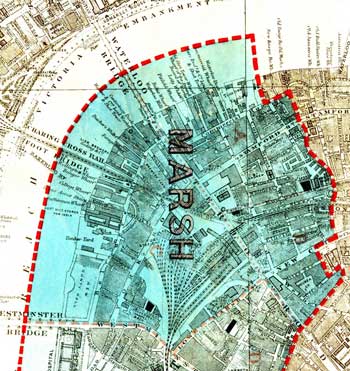Marsh Ward, Lambeth, 1918
By 1918 all the main Thames bridges had been built and Waterloo had been established as a main railway junction.
The docks, wharfs and industries along the riverfront still reflect the importance of the export and import industries and their dependence on river transport, although some , including a timber yard, a pottery and a flour mill, had been replaced by the "new" County Hall north of Westminster Bridge.
The resulting social impact on the working community, a legacy from the previous century, was still in the process of being addressed.
Reformers like Emma Cons concentrated on improved housing and education, providing more wholesome entertainment and coffee taverns such as the Old Vic at the corner of the Cut and Waterloo Road.
Click on the map for an enlarged image or click here for a larger, readable image (slower download).
Extracts from the map of the Metropolitan Borough of Lambeth showing the wards, parliamentary divisions and subdivisions into poling districts, 1918.





